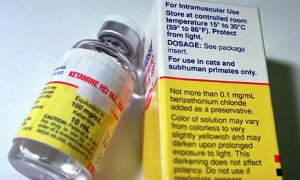 Classification: Hallucinogenic dissociative anesthetic
Classification: Hallucinogenic dissociative anesthetic
Commercial Names: Ketalar, Ketanest, Ketaset
Common Names/Nicknames: K, special K, ket, K2, kitties
Active Compound: Ketamine
Found in: Prescription ketamine powder, pill, or liquid
Mode of Consumption: Ingestion, injection, insufflation
DEA Scheduling/Legal Status (in US): Schedule III, legal with prescription with limited ability to refill
Effects:
Hallucinations, euphoria, dissociation, impaired coordination, anesthesia, hyperactivity, memory loss, nausea, anxiety, delirium
Risks:
Acute: Confusion, hypertension, increased heart rate, loss of motor control, accidental injury, respiratory depression, coma, fatal overdose
Chronic: Impaired memory, urinary tract disease, bladder scarification, permanent brain
Dangerous Drug Combinations:
Potentially fatal combination with alcohol, barbiturates, methaqualone, benzodiazepines, and other drugs that suppress breathing. Possibly dangerous combination with antidepressants, ecstasy, and other drugs that affect serotonin levels.
Special Considerations:
Associated with sexual assaults and/or rape.
And remember, if somebody may need help, play it safe and call for medical assistance.
“Students may bring an intoxicated or drug-impaired friend to University Health Services or to a hospital, or seek assistance from College residential life staff or HUPD, and by doing this, neither they nor the friend will face disciplinary action from the College for having used or provided alcohol or drugs.”
The Amnesty Policy
Harvard College Student Handbook
Sources:
Buzzed: The Straight Facts About the Most Used and Abused Drugs from Alcohol to Ecstasy (Third Edition), by Cynthia Kuhn, Scott Swartzwelder, and Wilkie Wilson. Published 2008 by W. W. Norton & Company.
National Institute on Drug Abuse (NIDA), part of the National Institute of Health (NIH) of the U.S. Department of Health and Human Services.
http://www.nida.nih.gov/DrugPages/
U.S. Drug Enforcement Agency (DEA), part of the U.S. Department of Justice.
Erowid Organization

